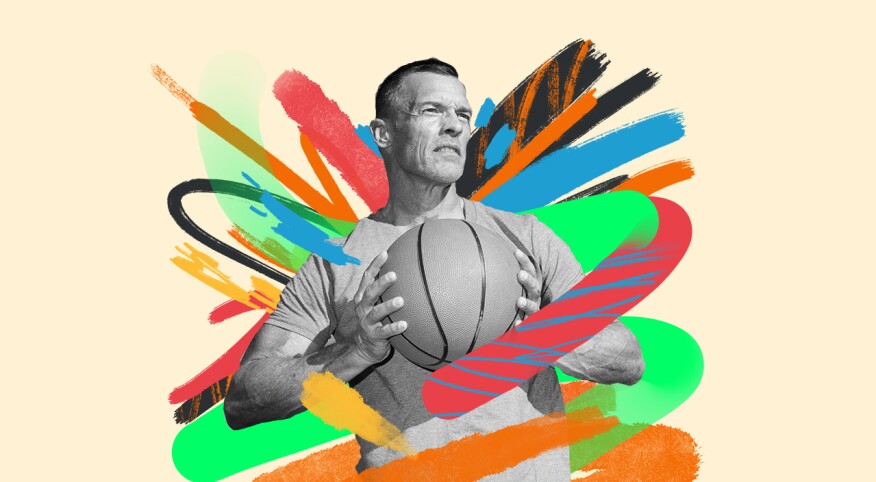Every week, I get the group text: “Hoops Thursday? In?” And every week for the last two-plus years, I ignore the message.
I want to play. I’m still physically able. But at 53, I worry that I’m one box out away from leading the league in IPPG (ibuprofen pills per game).
Some of my friends have also tapped out — too much risk at this age, we say. Why chance a long-term injury for the two-second glory of the once-in-forever game-winning left hook?
But I miss it. So last Thursday, I texted my friend: “If you only have a few people, I’ll come out this week.”
I’ve been playing pickup basketball for three decades, and it’s always ranked high on my list of favorite forms of exercise: the exertion, the competition, the joy of nailing a tough shot, the trash talk, all of it.
And I long for all the things that come with a weekly hoops game: the intensity that I can’t simulate on any cardio machine, the sense that I can block out life stresses when I’m playing, the head-to-head rivalries that no gamified exercise app can come close to.
I made a serious effort to prepare, using my 25-plus years of writing and research about health and fitness.
Yoga. Some research indicates yoga can be effective in reducing the risk of lower back pain and injury. I focused on hips and lower back moves, hoping to gain more strength and have a better range of motion.
Serious glute work. Whenever I pull my back, I can feel where the tightest muscle is, right in the dead center of my glute. When I knead it with a lacrosse ball or foam roller, it releases the tension. Though the science is not definitive on massage, some research shows pre-exercise rolling can be effective.
High-intensity cardio. I can’t simulate the banging that goes on when testosterone collides, but I made a point of integrating much more interval training into my regular routine over steady-level cardio, to help prepare for the stop-start nature of hoops.
I was anxious about how my body might hold up, but knowing the group was supposed to be small, I felt like I could take a toe-in-the-water strategy to these games.
I was the first to arrive at the court. One guy in his 20s I didn’t know arrived next, followed by a dude who looked like he could leap over an F-350. Exactly what I didn’t want: lots of guys, most of them younger, all looking way more athletic than I am.
In my first game, I felt like a hippo on ice skates. I couldn’t dribble, I missed three shots and I got pushed in the back once on a left-handed drive. I tried to make myself useful by passing and setting off-ball screens to free up my teammates.
I volunteered to sit the next game and even debated leaving. Now 12 guys were there, and surely it would turn into a full-court game, with running.
I didn’t need this. But how bad would that look — to play one game, pout for a bit and huff home?
So I went back in. I finally made a shot, a layup on a mini-drive. I also garbaged a low-post hook, and with our team down, I made two all-net 3-balls to help us creep back into the game.
That is what I wanted, to feel like I could do something. For 90 minutes, I still made plenty of mistakes, but I relaxed. I contributed. I got a taste of the intensity I’d missed. I felt good.
I left the court with no acute injuries. And the next morning, I crawled out of bed feeling creaky but uninjured, sore but undeterred.
Basketball is a physical game, but it’s also a mental one. You’ve got to drag yourself to the court, work past your fears that you’re going to make a fool of yourself or that your body is going to betray you. I can’t guarantee it’ll be easy, but oh, man, it feels so good to be back out there.
Next week, when I get the group text inviting me to play hoops, I won’t hesitate anymore. “I’m in,” I’ll write.

Bernardo Henning/Getty Images




